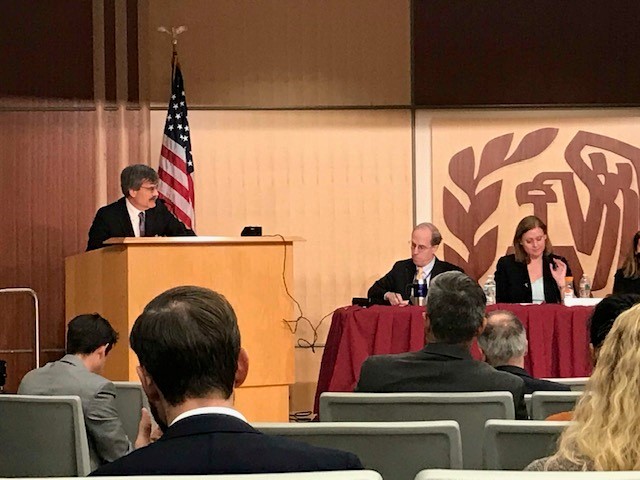Board Member and Advisory Committee Chair Tom Nichols represented S-Corp in Tuesday’s IRS hearing on Section 199A.
Tom was one of 26 witnesses to testify. As Tax Notes summarized:
Thomas J. Nichols of Meissner, Tierney, Fisher & Nichols SC said when taxpayers have losses from one trade or business and income from another, they are required to aggregate those amounts to determine the deduction amount, even though aggregation isn’t mandated when determining whether Form W-2 wages and basis in property can be combined.
Instead, taxpayers must jump through several hoops to determine if they can aggregate those businesses, Nichols added. He also said it’s important to keep in mind the likelihood of gaming Form W-2 wage context is low because it wouldn’t make economic sense for a company to pay $100,000 in wages to get a tax benefit under the Form W-2 rule of around $18,500.
Nichols added that it would help the government to ensure that the same people benefiting from the 199A deduction are also burdened by the Form W-2s. That would enable them to relax the business relation requirements.
The proposed rules require business owners to pass a five-factor test when grouping together different legal entities to calculate their 199A deduction. Grouping or aggregating these separate business entities is critical because of the guardrails limiting a business owner’s access to the deduction. Absent aggregation, many businesses that should get the full deduction will see it reduced or eliminated completely.
As Tom made clear, however, the five factors included in the proposed rules go too far. Requiring there to be common ownership of at least 50 percent of the entities being grouped and that all the entities have a common tax year will needlessly limit aggregation opportunities without materially increasing the integrity of the process.
In addition to getting the aggregation rules right, a number of witnesses expressed concern regarding the Specified Service Trade or Business (SSTB) definition and accompanying de minimis thresholds in the proposed rules. While banks and energy companies highlighted their particular concerns, common to those industries was support of significantly higher de minimis thresholds. As one bank argued:
Joseph Frampton of Paducah Bank and Trust Co. said Congress added the passthrough deduction to the code to provide parity for the corporate income tax rate reduction from 35 percent to 21 percent. However, after reading the proposed rules, it may make more sense for some small banks to convert to a C corporation, he said.
Frampton took issue with the de minimis test laid out in the proposed regulations, which states that if a trade or business has gross receipts of $25 million or less for a tax year, it won’t be treated as a specified service if less than 10 percent of its gross receipts are attributable to the barred services. And if a trade or business has gross receipts of more than $25 million, the applicable percentage drops to 5 percent.
Since Frampton’s bank has more than $25 million in gross receipts and 7 percent of the services it provides are barred from using the deduction, shareholders will be adversely affected, he said. At the fall American Bar Association Section of Taxation meeting in Atlanta on October 5, a Treasury official clarified that the de minimis rules have a cliff effect and that once the de minimis amounts are exceeded, the entire business is potentially banned from using the deduction.
Frampton suggested treating all bank income as qualified business income, raising the de minimis cap from 5 percent to 25 percent, or considering net income instead of gross receipts when calculating the de minimis rule.
For next steps, the IRS and Treasury will review the comments they received during the comment period and produce a final rule. With the clock ticking on calendar year 2018, we expect them to move quickly and produce something either prior to Thanksgiving or just after. Taxpayer’s need clarity, and the authors of the proposed rules understand that fully.
You can read S-Corp’s full comments on the proposed 199A rules here.

